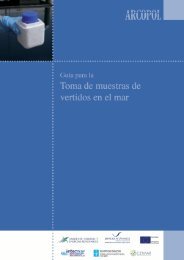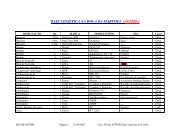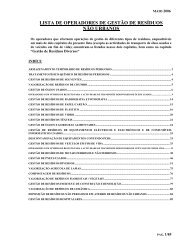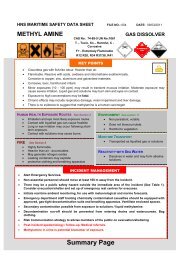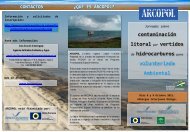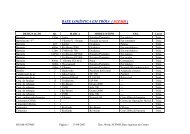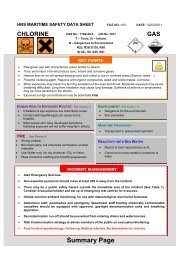ammonia gas (d) - Arcopol.eu
ammonia gas (d) - Arcopol.eu
ammonia gas (d) - Arcopol.eu
Create successful ePaper yourself
Turn your PDF publications into a flip-book with our unique Google optimized e-Paper software.
HNS MARITIME SAFETY DATA SHEET FILE NO.: 003 DATE: 09/03/2011AMMONIACAS No: 7664-41-7 UN No: 1005F- Flammable, T – Toxic, C - Corrosive,N – Dangerous to EnvironmentR10, R23, R34, R50S(1/2), S9, S16, S26, S36/37/39, S45, S61GAS (D)SECTION 10: WASTE DISPOSALWASTE CATALOGUE CLASSIFICATION : 28-05-08 inorganic chemicals, <strong>gas</strong>esWASTE DISPOSAL METHODENVIRONMENTALPATIENT CLOTHINGAmmonia is volatile and non persistentDissolves in water to form ammonium hydroxide. N<strong>eu</strong>tralise with weak acid.Ammonia is volatile and non persistentDissolves in water to form ammonium hydroxide. N<strong>eu</strong>tralise with weak acid.Double-bag soiled clothing and place in a sealed container clearly labelled as abiohazard. Wash soiled clothing thoroughly if not to be disposed as waste.Handling & Storage: Ammonia is typically stored as a liquified <strong>gas</strong> under pressure or in refrigerated low pressuretanks, or as an aqueous solution. Store in a cool, well-labelled, well-ventilated, fire-proof area, preferably awayfrom all sources of ignition and heat as well as incompatible materials. Store below 50 o C. Outdoor tanks should bepainted in non-reflective paint to reduce temperature effects. Refrigerated <strong>ammonia</strong> should be warmed prior totransfer. Transfer lines should be purged of air when used for <strong>gas</strong>eous <strong>ammonia</strong>. (OSHA)Transport Information: IMDG Class 2.3. Packing Instruction P200, EmS FD,SU.ADR / RID Regulations Class 2 Classification Code 2TC. IATA Class 2.3.SECTION 11: ECOLOGICAL INFORMATIONToxicity Data: Ammonia exists naturally in the environment produced from decay of organic matter. Ammonia<strong>gas</strong> will be removed from the atmosphere by rain wash-out and reaction with sulphate ions.Significant quantities released into the water can have severe short-term effects as <strong>ammonia</strong> is highly toxic to fish.In water <strong>ammonia</strong> is very soluble and will be rapidly converted under aerobic conditions to less toxic nitrate ions.Acute toxicityBioassay conditions/analysed parametersSpecies Age/Size TemperatureSalinity ‰ LC50 -48h LC50 96hDaphnia magna(Water flea)(°C)- - - 24 - 180 mg/LCatfish - - - 0.28 mg/LPimephalespromela (fatheadminnow)- - - 8.2 mg/LReferenceToxnet HSDBIn soil <strong>ammonia</strong> has low mobility and will adsorb strongly to solid particles. Ammonia does not bioaccumulate.Plants have a high affinity for <strong>ammonia</strong> <strong>gas</strong> via stomata. In aerobic soil <strong>ammonia</strong> will be converted to nitrate insoils (nitrification). Nitrification and plant uptake can lead to acidification of soilsCritical exposure concentrations for protection of vegetation and ecosystems are given for <strong>ammonia</strong> as:3.3 mg m -3 (hourly),0.27 mg m -3 (Daily) and 0.023 mg m -3 (weekly)(WHO Working Group on Ecological Effects, Les Diablerets, Switzerland, 1994)PAGE 10 OF 11



